It takes an army to put together a movie, and today, we’re going to investigate a role that is largely unknown to the vast majority of movie-viewers. The role of a colorist.

The movie industry is full of incredible jobs, a colourist being one of them. We’ll be discussing what a colourist does and what it takes to become one. Stay tuned for everything you need to know about designing a film’s colour scheme.
What Is A Colorist In Film?

A colorist (or Colourist if you’re from this side of the Atlantic) is also known as a Grader or a Post Digital Imaging Technician. It is a post-production role. This means that the colorist gets involved only once a film has been ‘locked’ and completed.
The main function of the job is to help define the mood of a film by defining its colours. Working with the director and the director of photography, a colourist will help decide on the colour palette a movie uses. Balancing saturation and hyper-colour options with restraint and noir. As well as deciding whether primary colours, or milky colours best represent the mood of the piece.
This role is much more than simply applying a digital filter to the film image. In fact, ever since the word ‘Technicolor’ first appeared in the opening trails of films, movies have benefitted from the work of colorists.
Back when film was a totally analogue process, a colorist’s role was primarily concerned with changing the exposure time when developing film. This was in order to achieve proper lighting for the final production.
As movies have become digital, the methods have become far more sophisticated. Therefore, the colorist’s job description has expanded to include changing the colours, tint and hue of shots to realise the director’s creative vision.
What Is A Colourist & What Do They Do?
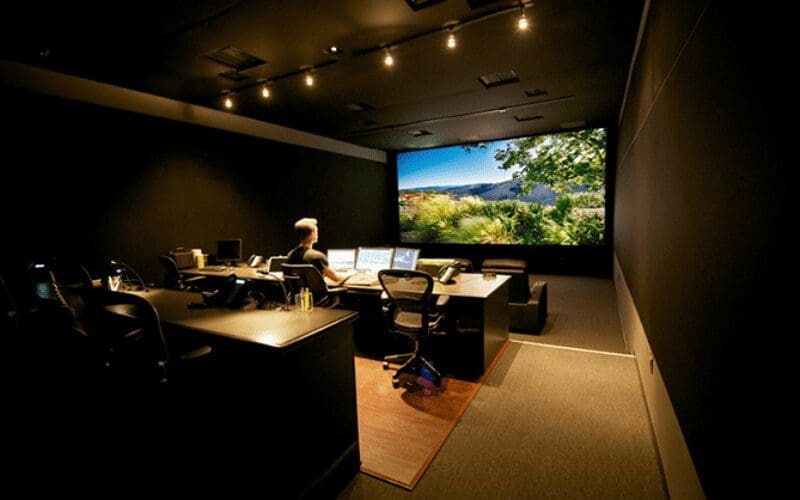
Now we have our colorist meaning, let’s look at the job in more detail.
What Is A Colorist – Grading & Correction
There are two main areas that colorists focus on. Colour correction and colour grading. Whilst those terms are often used interchangeably, there is a subtle difference.
Colour grading is the process of adjusting the colour of a film for technical or creative reasons. Whilst colour correction is used specifically to correct mistakes, or to make the film appear more natural or real.
Cameras capture light in quite a different way to a human eye. This means that there can often be problems of over-exposure on the final cut of the film.
Similarly, there might be slight problems in the film. It can be anything from poor, or changing lighting conditions, to the colours of the actors and scene not looking quite right. This is where colour correction comes in. The colourist will adjust the colours and the white balance to more closely match the colours our brains and eyes expect.
Colour grading, on the other hand, was once upon a time a cost-saving exercise. Shooting at night was generally more expensive and far more difficult technically. So, studios would shoot during the day, and the colorist’s job would be to make that scene look like it was taking place at night. They did this by enhancing the blue colours and reducing the exposure to darken the shot.
But in a modern movie setting, colour grading is more about realising an artistic vision. In colour grading, you are thinking about:
Your Key Elements
This makes sure your key elements (things like skin) look correct in the scene, and you don’t have your actors coming across as pale or red-faced.
Stylizing
Not only are you looking to style a shot a certain way, once you have defined how a movie scene should look, you are also trying to make sure all the different cuts in a scene look like they were shot in the same moment.
So, if you have enhanced the reds and yellows for a sunset, you need to make sure that when the camera cuts to your characters talking on the deck of the boat, those same reds and yellows are also present.
Adding Depth
This is not only about making the image itself feel deep and compelling. You are also responsible for using the colours and lighting tones to shape the scene around the focal point.
In his LinkedIn Learning special, Taylre Jones talks about how he took the shot of a character crying and made the character’s surroundings much darker to draw attention to the face. He also enhanced the blues to further enhance the sense of sadness.
Quality Control
A colorist’s job is also to make sure you are sticking within broadcast guidelines for saturation and luminescence. This is in order to make sure that your film can be broadcasted.
These are called the Broadcast Legal Limits, and it is the colorist’s job to make sure the film doesn’t stray beyond those limits.
Examples Of Great Colour Work In Film
Now that we know what a film colourist is, let’s look at some examples.
If you want to see some great colour work on a movie – we recommend the following.
Amélie
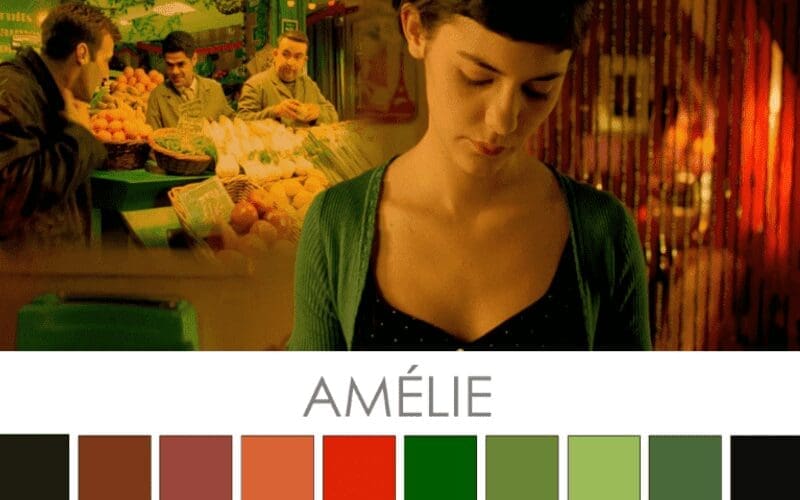
The heavy use of bright colours in Amélie really adds to the playful, almost dreamlike nature of the character.
In Amélie, the colours follow what is known as the Three Colour Rule. Which around 60% of the frame should be taken up by your primary colour. Around 30% for the secondary colour and around 10% for your accent colour.
As you can see from the still here, the primary colour is brown-orange, the secondary colour is green and the accent is red. However, throughout the film, they also manage to break a few rules by injecting a higher proportion of green. As well as adding a fourth colour that sometimes replaces green altogether – blue.
Batman: The Dark Knight
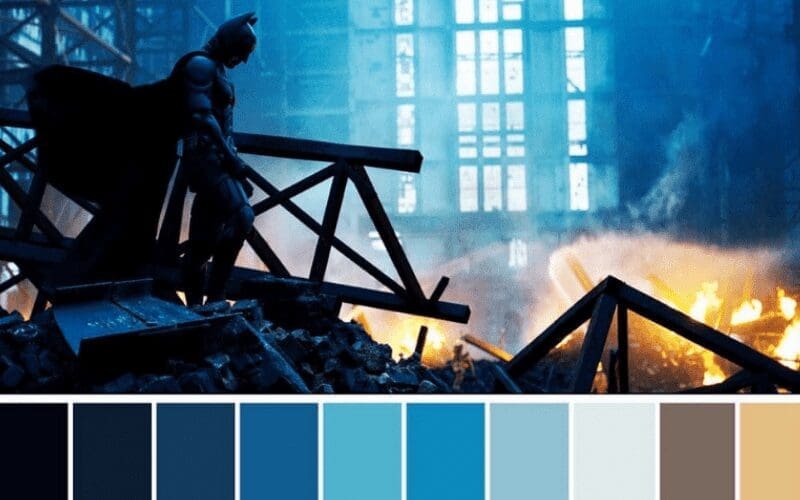
The second instalment of Christopher Nolan’s Batman trilogy is arguably the best and certainly the most iconic.
The colour palette is interesting. It actually starts in the mind of the viewer well before the opening scene is rolling.
All of the trailers were dark with lots of blue in the palette. Even the opening credits and the studio logos were dark. In contrast, the first scene is a bank robbery in brilliant sunshine.
Throughout the movie, they switch palettes. When Batman isn’t around, the palette is lighter colours – more beige and olive. However, once Batman shows up, it’s all back to blues and blacks with accent colours of yellow and orange.
The Science Of Sleep
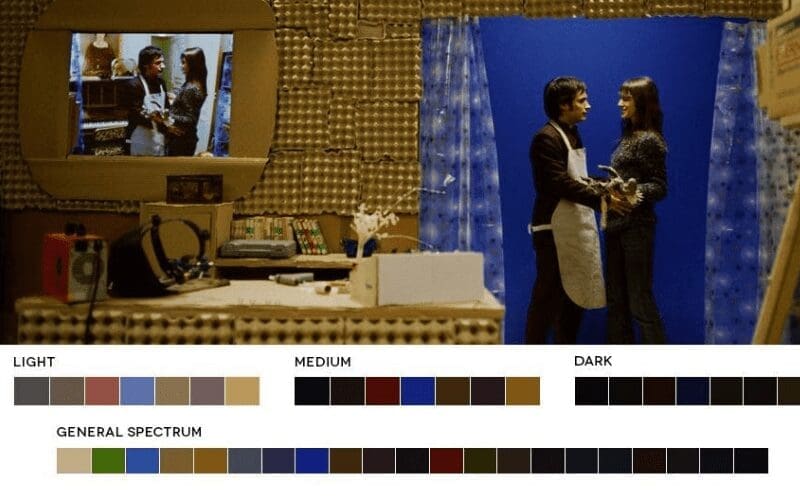
Fans of Michel Gondry will know that his movies often possess a wackiness to them and the Science of Sleep is no different.
The heavy use of primary colours make the dream sequences seem more vivid than the real-life scenes.
Oh Brother, Where Art Thou?
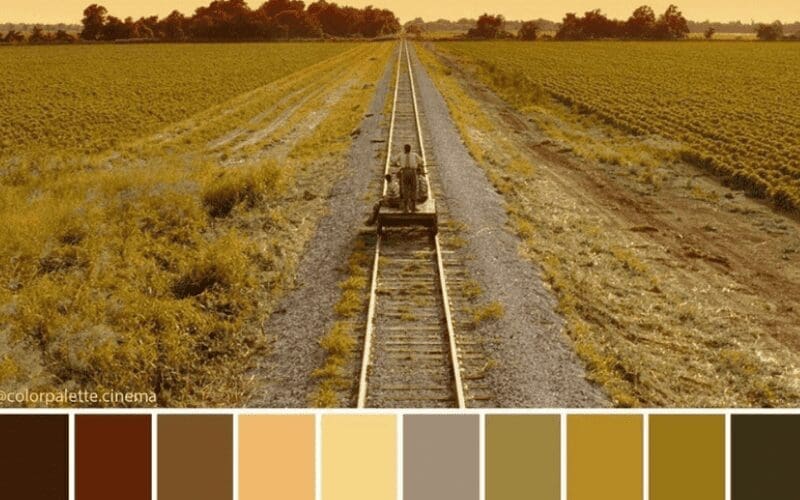
Like any Coen Brothers movie, Oh Brother… is incredibly well shot with some breathtaking landscapes.
Throughout the movie, there is a sense of heat and dust highlighted by the heavy use of browns, reds, and yellows.
The Grand Budapest Hotel

Wes Anderson is well known for his very square, almost theatrical shots and his incredible use of colour.
In the Grand Budapest Hotel, pinks and purples are the main devices both in the landscape shots but also in the interiors and staff uniforms.
It all combines to add a sense of whimsy and other-worldliness.
How To Be A Colorist For Film
In this section, we will be looking at the necessary skills needed to navigate the colorist job market. Let’s dive in!
Do I Need A Degree?

You don’t need a degree to be a colorist. However, an understanding of light and colour is obviously a key facet of the job role.
A lot of colorists come from academic backgrounds that involve Art, Photography, and Film Production.
Understanding topics such as Physics and Computer Science are also useful – especially in the digital age of filmmaking.
It’s also essential to be a good communicator. You need to be able to balance inputs from a range of different sources and work with a number of different people to deliver the final product.
So, understanding and conveying the position of the director, editor, director of photography, and the legal requirements of the broadcast agencies is a big part of the job.
Colorist Training

There is quite a lot of colorist training available. The International Colorist Academy offers training online and in key cities around the world. It’s also important to understand the main software involved.
While Adobe Premiere Pro and After Effects both have colourising tool sets, the industry standard is DaVinci Resolve.
There are loads of tutorials on all three software on YouTube. As well as on platforms like LinkedIn and Fiverr. You can also access specific training courses through different academies.
Career Journey

In terms of the career journey, most colorists start out in a junior role at a post-production house. Typically as a runner or internship/work experience role.
Whilst you are looking to get into the industry, or even if you have a junior role already, it’s vital to build up a portfolio of work. This can be indie films, short films, freebies, student projects. Anything you can get your hands on in order to build a compelling portfolio. This will allow access to a network that you can use as a springboard to get the gigs further down the line.
According to Taylre Jones, most of the work he’s done has been through word-of-mouth referrals that he’s built continuously since doing small projects and freebies as he built up his portfolio.
What Is A Colorist – Salary

A lot of colorists are freelance and work project-to-project. So, it largely depends on the kinds of projects you are working on.
Tyler Roth (who worked on the movie Porto) suggests your week could be split 70% on commercial work, 25% on feature films and 5% on short films yielding an salary between $36k – $69,500 in the US.
In the UK, working in a senior colorist role for film and TV could earn you up to anything between £55,861/yr and £192,942/yr per year.
Now You Know Everything About A Film Colourist

While most people will have no idea what a film colorist does, it is easy to see the attraction of the role.
You get to work on a huge range of different projects. Including some of the most exciting movies and TV shows in a creative and dynamic way that allows you to really help shape the final cut of the project
It’s a rewarding and challenging job where you will learn something everyday.
Got What It Takes To Be A Colourist?
We hope that you enjoyed this guide! If you’re interested in movie production, why not check out some more of our articles such as, How To Become A Movie Producer, How To Become A Filmmaker In 4 Easy Steps, and What Is Foley Sound In Film & How Can I Make It? Or have a look at our website to learn more about sync placements in films and tv.
Furthermore, get in touch with Music Gateway to see how we can help you. Use this link to get in touch with us to discuss any opportunities such as Sync Licensing, Music Licensing, Music Clearance, Sync Libraries or Music Libraries, etc., you may want to take further.
You can book a call with Sam – Head of Sync Licensing – as a potential lead. We are always happy to talk to musicians like you. We look forward to hearing from you.









